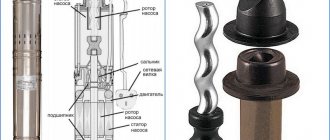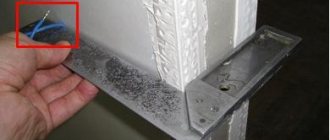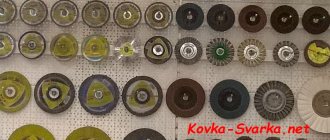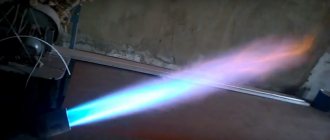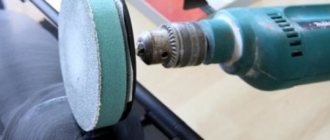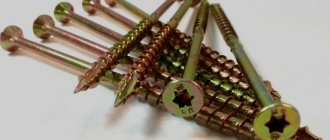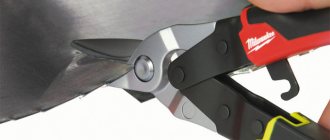Before using a submersible pump for a well, experts advise you to get acquainted with the types of such equipment and understand in which cases one should give preference to one or another model. All types of submersible pumps, despite the variability in design, have common features that distinguish them from surface hydraulic machines. Such features also determine the scope of application of submersible well pumps.
Submersible pumps are designed to supply water from wells, but can be used to draw water from mine wells, reservoirs and open sources, subject to the main operating condition - complete immersion in the pumped liquid
Device and design features
At home, two types of pumps are used:
- Submersible.
- Superficial.
In the first case, the pump is lowered into the source to a certain depth. The entire control unit remains on top.
Surface water devices are installed close to the water intake. A pipe goes down through which the liquid is sucked in. The practicality of this device depends on the water level. They can be used for sources up to 8 meters.
Advice! If the depth reaches about five meters, then it is better to purchase a manual well pump.
Submersible is used when constructing an artesian or filtration source. It is important to consider that surface models are noisy, so for installation you should build a caisson or place them in a special room.
Principle of operation
Surface models draw in water. As for the submersible ones, they push it out. Given this feature, it is important to know the depth of the source.
Advice! The technical data sheet of a particular pump indicates the power of the device and the ability to lift water to a certain height. When making your choice, consider this information.
Surface devices have different operating principles. The following options are known:
- Manual.
- Self-priming.
- Ejector.
Submersible units are divided according to the principle of operation:
- Centrifugal.
- Vibrating.
- Screw.
- Vortex.
- Artesian.
- Deep.
All these types of pumps have different operating principles.
Device
A high performance pump will have a more powerful body. This also affects the weight of the product. The peculiarity of the design of a particular pump is that it works without heavy loads. Accordingly, the choice of a well pump should be made with a small power reserve.
Leading manufacturers of submersible well pumps
Both domestic and imported submersible pumping devices deserve equal praise. Let's consider popular foreign designs.
- Grundfos. A well-known brand specializing in the production of pumping equipment in Denmark. The concern produces submersible and surface models. The main feature of the products is the use of stainless steel in the production.
- Marina. Pumps of this brand have a centrifugal internal design with a single impeller. Such devices are used to fill large reservoirs with water from wells and deep wells.
- Speroni. These units are considered quite expensive. They are designed to pump only perfectly clean water that is suitable for drinking. This is due to the fact that a mesh filter is installed inside, which is capable of protecting the internal mechanism only from coarse rocks (up to 3 mm).
- Amarex. Units with normal suction and one working monoblock. Such units can be single- or multi-channel. The devices of the declared trademark are equipped with explosion protection and have an asynchronous three-phase motor.
As a rule, products from foreign manufacturers are distinguished by high levels of practicality. Of course, equipment with multiple degrees of protection will cost many times more than classic modifications of devices.
Among the Russian brands producing deep well pumps, it is worth highlighting:
- “Irtysh” (the density of liquids should be no more than 1100 kg/m³);
- “Baby” (designs vary greatly in quality depending on the cities in which the manufacturer’s branches are located. Only those products produced in Livny receive positive reviews);
- "Dzhileks" - models reminiscent of Chinese pumping units. There are several options. They differ in power and method of operation.
However, each of the proposed brands provides its consumers with a wide range. From the listed manufacturers, you can select the appropriate unit for your individual application conditions.
To use deep-well pumps, it should be taken into account that the static water level in the well must correspond to the characteristics of the equipment (look on the packaging or check with a consultant).
What types are there?
Water devices are divided into two categories:
- Submersible.
- Superficial.
Each of these types of devices works according to a different scheme. Their features:
Superficial
| Manual | Effective if there is no need for a continuous stream of jets. By pressing the lever, the water rises from the depths. With a few clicks you can quickly fill a bucket. A hand pump for water from a well, having a simple design, is often made by hand. It consists of a piston, a cylinder and two valves (water or air). The main element is the lever that moves the valve. It will save the family budget due to its independence from electricity. At the same time, it will work on the Abyssinian no less than the purchased one. You can learn how to make a hand pump yourself from the prepared video material in this article. |
| Self-priming | Self-priming has an electric drive. The housing itself does not come into contact with liquid, and must be hidden from rain. Such devices are connected to the source by a hose, or pipes are laid. It is mandatory to use a check valve. The weak point is the lack of a cooling system. The design has one control unit for turning the motor off/on. In order not to be distracted by the pumping process, you need to purchase automation separately. On average, they are capable of creating a pressure of about 8 m. For a home, this may not be enough. Similar installations are used when filling small containers |
| Ejector | If the water depth ranges from 10 to 25 m, then a device equipped with an ejector is used. This means that the secondary circuit is made from a pipe of smaller diameter. Liquid will be pumped through it at high speed, which will lead to an increase in pressure in the supply pipe. As a result, this will have a positive effect on the overall water pressure in the system. This solution allows you to lift liquid from great depths. However, the pump's performance decreases. Among the disadvantages is the fact that they are noisy during operation. |
How to remove a pump from a well - the correct procedure
In life, situations often arise when a pump can get stuck between the walls of a well. Each owner approaches this problem differently. We will tell you about the most effective methods and tips that will help you get a pump out of a drilled well:
- First of all, you should tighten the safety rope and hit it several times with a hammer. In this case, vibrations are transmitted to the cable to the pump and deposits accumulated on it are destroyed. This method can take a lot of time and effort - you need to be prepared for the fact that it will take several days to remove the unit;
- If auxiliary objects are used to pull the pump out of the well, then they must be secured by the head to a stationary object near the well;
- To push equipment inside the well, experts advise using a pipe whose diameter will be slightly smaller than the diameter of the well.
Whatever method is used, do not use too much force. As a rule, this leads to destruction of the pump or breakage of the safety cable.
Advantages of devices: which one to choose?
| Kinds | Advantages |
| Submersible |
|
| Superficial |
|
What to choose – a deep-well pump or a pumping station?
To pump out a liquid medium from a deep well or well, not only submersible pumps can be used, but also pumping stations consisting of a whole set of technical devices. The question of what to use to service a well or borehole - such a station or a deep-well pump - is often faced by owners of country houses and summer cottages who have decided to equip an autonomous water supply system.
The pumping station, in addition to a powerful surface pump, includes a storage tank called a hydraulic accumulator. The liquid medium pumped out from a well or well is first sent to such a tank and only then, when a certain pressure is established in the hydraulic accumulator, is it supplied to the pipeline system.
The pumping station will provide a country house with water supply automatically
If we compare a pumping station with a deep-well pump, then, along with higher productivity, it also has significant dimensions, which should be taken into account when choosing a location for its installation. In addition, the installation of a pumping station will require more financial resources than the purchase of a submersible pump.
In any case, when choosing pumping equipment to equip an autonomous water supply system, you should be guided by the parameters of the well or well from which water is to be pumped, as well as the required amount of liquid for water supply and irrigation needs and the parameters of its flow.
How to choose according to parameters?
It is necessary to take into account those characteristics. Let's consider the most important ones that will help you with your choice:
- Depth.
- Consumption.
- Diameter of source and casing.
- Pressure
- Well debit.
Consumption
This parameter is otherwise known as pump performance, measured in liters per unit of time. Some models are capable of delivering up to 20 liters per minute, while others up to 200.
You need to decide how many people will live in the house permanently. On average, up to 200 liters are needed per person per day. Also consider whether the source will be used for watering or if liquid will be used for other purposes. The result obtained should be divided by 12 (hours), since the device does not work at night and you can find out the approximate consumption per hour. And if you divide the resulting amount by 60 (min), you will know the flow rate/min. Based on these numbers, you will make the right choice of pump based on performance.
Water pressure
To determine this indicator, you need to consider the following factors:
- Distance of the pump from the water surface.
- Distance of the unit from the house.
- Pipeline length (resistance).
When calculating the head, 10 meters horizontally and vertically equals 1 m of head. If the system has a hydraulic accumulator, then 1 Atm equals 10 m of pressure.
Source depth
An important indicator that will help you choose a device for an artesian well. The manufacturer indicates the maximum permissible immersion depth of the pump in the data sheet.
Well and casing diameter
Typically, a garden spring can have a diameter from 70 to 102 mm. The pump you choose should be smaller than the casing pipe.
Well production
If you use deep pumps in wells with a small flow rate, the pump will constantly turn off. Accordingly, the productivity/power of the installation must be equal to the debit of the source. More precisely, the power of the device should be less than the volume of the entire liquid.
General recommendations
When choosing and installing a deep-well pump for a well, experts advise relying on the following points:
- intensively working filters slightly reduce the pressure;
- problems often arise at joints that are under water;
- pumps can get stuck in wells, as a result of which the owner risks losing the source of water supply and the device itself;
- It is advisable to fasten electrical cables to pipes or hoses using harnesses;
- if it is necessary to pull the pump by a pipe (hose, cable), you need to monitor the integrity of these elements and their uniform lifting.
If you cannot get the device yourself, it is better to contact a specialist. They use the latest equipment to help solve problems with stuck and lost devices.
Optional equipment
Automation for downhole devices allows you to forget about the operation of the pump. Let's look at some types of equipment and connect it according to the diagram.
Automation
Divided into 3 generations:
- 1st generation: pressure switch, dry run blocker, float switch;
- 2nd generation: an electronic device that has several sensors installed in the pipeline, on the pump and other places. Thanks to it, the following work is performed: water level recording, dry running blocking, emergency shutdown, engine temperature control;
- 3rd generation: has advanced functions, with precise control of operation.
Popular models for home and garden
Let's compare the most famous:
- DAB IDEA 75M. Household vortex unit. Delivers liquid from 10 m. Easy to use. Ideally combined in energy consumption and technical requirements. characteristics. The rotation of the brass wheel may become stuck.
- Aquario ASP 1E-30-90. Centrifugal submersible unit, the ideal solution for the dacha. Lifts liquid from 20 m. Silent operation. An obvious disadvantage is damage to the motor after several years of operation.
- VORTEX CH-50N. The body of the submersible apparatus is made of high-quality stainless steel. A thermal relay is provided. Designed for up to 50 m of immersion. After a certain time, the impeller key changes shape, oil leaks, and the engine burns out.
- Wilo TWU 3-0501-HS-E-CP. This is a high pressure pump for source depths up to 150 m. Best for artesian water. Creates a pressure of up to 26 m. Has many levels of protection. There are practically no disadvantages.
